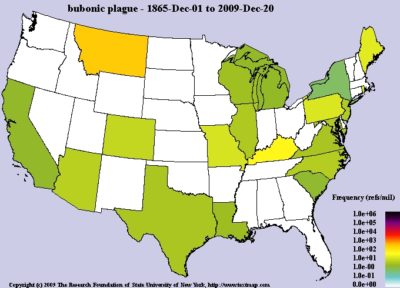Bubonic plague cases have been reported in animals in both California and New Mexico. The deadly disease which killed more than 50 percent of the European population centuries again appears to have emerged once again. Early last fall, two people in Oregon and a Colorado girl also caught the bubonic plague.
New Mexico Bubonic Plague
Officials in New Mexico have warned citizens in Santa Fe County in the East Mountain region that the bubonic plague was found in two dogs. Humans can contract the bubonic plague by touching an animal that has either become ill or has died from the disease. Health officials feel that rodents might be the host for fleas infused with the “Black Death” disease. Residents in the Santa Fe area are being urged to keep both their cats and dogs away from rodents. Such a task will be extremely daunting if the pets ever venture outside. Although New Mexico health officials admit they are not entirely sure that common rodents, squirrels, rabbits, and chipmunks are the bubonic plague carriers, they do believe the roaming critters are the most likely culprits.
New Mexico Environmental Health Department physician Dr. Mark Dimenna had this to say about the two dogs infected with the plague:
“It is the plague. It is the bubonic plague, the Black Death. It’s the same organism that it always has been.”
California Bubonic Plague
Increased “plague activity” has also reportedly been reported in the El Dorado County area in California. Local health officials have also warned residents to keep their animals away from squirrels and chipmunks. While the warning could help reduce infection of domesticated pets, it would be nearly impossible to protect livestock from interaction with common rodents. By the time health officials detected a horse from a public stable or youth camp had the bubonic plague, it could already have been handled by dozens of adults and children.
El Dorado County Public Health Officer Dr. Alicia Paris-Pombo had this to say about the case of bubonic plague in California:
“Plague is naturally present in many parts of California, including higher elevations of El Dorado County, so we all need to be cautious around animals that can carry it.”
Colorado Bubonic Plague
Little Sierra Jane Downing, 7, contracted bubonic plague last September when she buried a dead squirrel during a camping trip. The Black Death incident was the first known case of the bubonic plague in Colorado in six years. Although she was critically ill, Sierra fortunately recovered from the plague. Sierra Downing also suffered from a high heart rate and low blood pressure, alerting the St. Luke’s Medical Center staff to the possibility that they were dealing with a potentially fatal archaic virus. When she arrived at a local hospital, she had a seizure and presented with a 107 degree temperature. The Downing family was lodging at the Cimarrona Campground in the San Juan National Forest near the Williams Creek Reservoir.
The hidden secrets of making herbal medicines…right at your fingertips!
Dr. Jennifer Snow had this to say about the Colorado bubonic plague case:
“You learn about it [the plague] in medical school during microbiology, but I had never seen a case of it before. It’s one of those things that you don’t necessarily expect to see. But, it’s definitely one of those things you don’t want to miss.”
Oregon Bubonic Plague
 Just days after Sierra Downing contacted bubonic plague in Colorado, an Oregon woman also became infected while trying to save a stray cat that was choking on a rat. The Oregon bubonic plague victim was scratched while attempting to help the feline. Doctors credit the early detection of the horrific disease with the ability of the animal love to recover. The woman went to the doctor four days after the scratch when her lymph nodes became swollen and she was experiencing both chills and a high fever.
Just days after Sierra Downing contacted bubonic plague in Colorado, an Oregon woman also became infected while trying to save a stray cat that was choking on a rat. The Oregon bubonic plague victim was scratched while attempting to help the feline. Doctors credit the early detection of the horrific disease with the ability of the animal love to recover. The woman went to the doctor four days after the scratch when her lymph nodes became swollen and she was experiencing both chills and a high fever.
The unnamed Colorado bubonic plague victim contacted the disease around the same time as her friend Paul Gaylord garnered national attention, also becoming infected with the Black Death. Gaylord lost multiple toes and fingers after they had become blackened from the infection. Although he also survived the plague, he spent months on life support in a Portland area hospital. The stray cat which the woman was bitten by while trying to save, had been adopted by her friend Paul.
Crook County Health Department official Karen Yeargain had this to say about the bubonic plague cases in Colorado:
“We got to her [unnamed woman] just in time. If this hadn’t happened we would have had another critically ill person on our hands.”
Bubonic Plague History and Facts
The first know occurrence of the bubonic plague was in China in 1334. Symptoms of the deadly disease include swollen, tender, or painful lymph nodes, headache, fever, chills, and weakness. Modern victims of the plague often (and understandably) mistake the Black Death symptoms for those of the flu. Health officials largely believe that plague symptoms present within two weeks after exposure to an infected animal or carrier flea.
The last bubonic plague outbreak of global proportion occurred in 1855. During what is often described as the “Third Pandemic” outbreak, approximately 12 million people perished. The pandemic wave was not entirely thwarted until 1959. The Black Death was believed to have been spread via fleas from international cargo ships, rats, and infected humans. Once the plague took on pneumonic attributes, it spread from human to human. Some researchers believe the Third Pandemic is responsible for the first known pandemic to swirl through America—the San Francisco plague which killed scores of people between 1900 and 1904.
There have been an estimated 1,000 cases of the plague reported since 1900. Instances of confirmed plague cases in the United States have been largely centralized in the states of California, New Mexico, Colorado, Nevada, Arizona, and Oregon.
An exact bubonic plague death toll is extremely difficult to measure due to the lack of thorough records from medieval times, but researchers estimate about 200 million people have died from the Black Death since the first case was reported. During the early years of the plague, it was often referred to as “The Pestilence” and “The Great Mortality.”
Our increasing mobile modern society would surely increase the likelihood of a quick spread of the bubonic plague, should a true pandemic emerge. One infected person on an airplane or cruise ship could infect hundreds of people in mere days.
How concerned and prepared are you for a bubonic plague pandemic?
 Off The Grid News Better Ideas For Off The Grid Living
Off The Grid News Better Ideas For Off The Grid Living





